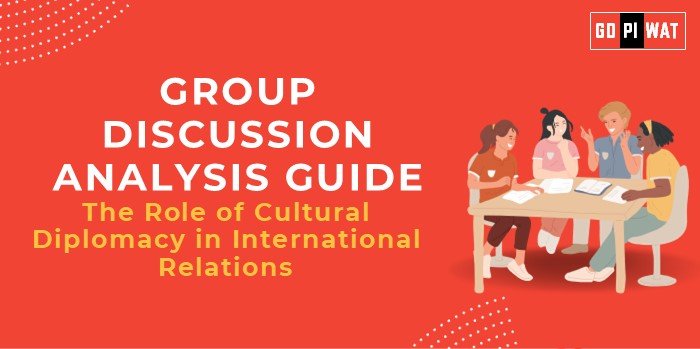📋 Group Discussion Analysis Guide: The Role of Cultural Diplomacy in International Relations
🌐 Introduction to Cultural Diplomacy
Opening Context: In an era of globalization, cultural diplomacy has emerged as a pivotal soft power tool for fostering international understanding and cooperation. It leverages cultural exchanges, arts, and shared heritage to bridge geopolitical divides.
Topic Background: Cultural diplomacy refers to the use of cultural exchanges and initiatives to promote mutual understanding between nations. Rooted in ancient traditions of cultural sharing, it gained prominence during the Cold War as a means of ideological influence and has since evolved into a key strategy in modern international relations.
📊 Quick Facts and Key Statistics
💰 Economic Impact: Cultural and creative industries contribute 3% to global GDP (UNCTAD 2023).
✈️ Exchange Programs: Over 2 million students participate in international cultural exchange programs annually.
🏛️ Tourism Link: Cultural tourism accounts for 40% of global tourism revenue.
🤝 Stakeholders and Their Roles
- 🏛️ Governments: Promote cultural diplomacy through embassies, festivals, and exchange programs.
- 🌐 International Organizations: Entities like UNESCO support global cultural heritage preservation and initiatives.
- 🎭 Private Sector: Cultural industries, media, and arts play a role in spreading cultural narratives.
- 📢 NGOs: Facilitate grassroots-level cultural exchange and understanding.
🏆 Achievements and Challenges
✨ Achievements:
- 🧘 India’s Soft Power: Yoga and Bollywood are cornerstones of India’s cultural diplomacy.
- 🎓 China’s Confucius Institutes: Operate in over 100 countries, promoting Chinese language and culture.
- 📚 France’s Alliance Française: Over 800 centers globally.
- 🎵 South Korea’s Hallyu Wave: Boosts national image and economy.
⚠️ Challenges:
- 📑 Cultural Appropriation: Concerns over exploitation of cultural heritage.
- 🌍 Political Tensions: Cultural diplomacy can falter during geopolitical conflicts.
- 💸 Sustainability: High costs and limited funding for long-term programs.
📚 Global Comparisons:
- ✅ United States: The Fulbright Program is a cultural diplomacy success story.
- 🎌 Japan: Uses anime and technology as diplomatic tools.
🗣️ Structured Arguments for Discussion
Supporting Stance: “Cultural diplomacy fosters mutual understanding and long-term peace by transcending political boundaries.”
Opposing Stance: “While beneficial, cultural diplomacy often reflects hegemonic ambitions, overshadowing smaller nations’ voices.”
Balanced Perspective: “Cultural diplomacy is a valuable tool but must be inclusive and equitable to avoid reinforcing power imbalances.”
💡 Effective Discussion Approaches
- 📜 Opening Approaches:
- Cite statistics on cultural exchange impact.
- Mention historical examples, like Cold War cultural programs.
- Pose a thought-provoking question on soft power.
- 🛠️ Counter-Argument Handling:
- Highlight benefits with data, then acknowledge limitations with examples.
- Suggest equitable frameworks for international cultural initiatives.
📈 Strategic Analysis of Strengths and Weaknesses
- 🏅 Strengths: Builds mutual respect, enhances soft power.
- ⚠️ Weaknesses: Limited reach in conflict zones, funding constraints.
- 💡 Opportunities: Digital platforms for virtual exchanges.
- ⚡ Threats: Political misuse, cultural erasure.
🎓 Connecting with B-School Applications
- 📚 Real-World Applications: Projects in international marketing, tourism, or cultural resource management.
- 💬 Sample Interview Questions:
- “How does cultural diplomacy compare to traditional diplomacy?”
- “Discuss an example of cultural diplomacy influencing international relations.”
- 🔑 Insights for Students: Opportunities in public policy, cultural event management, and cross-border marketing strategies.


